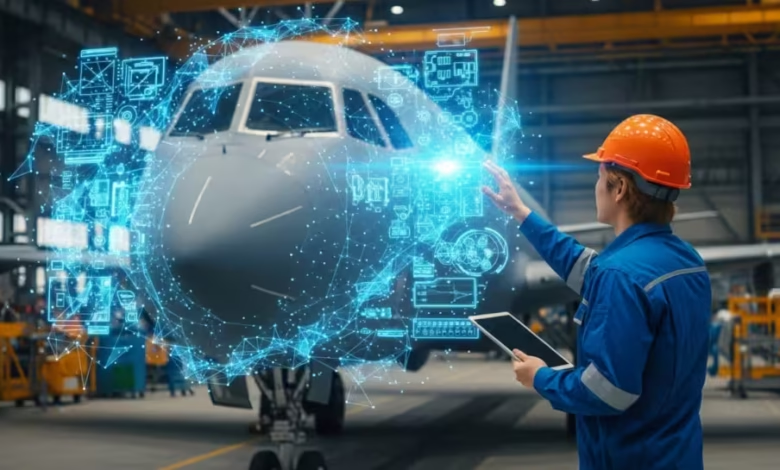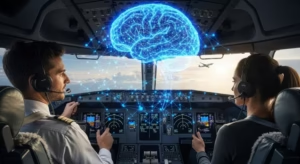AI in Aviation: The Future of Autonomous Flight

The blog post AI in Aviation: The Future of Autonomous Flight explores the transformative role of AI in aviation, detailing how it paves the way for autonomous flight. It examines pilot assistance systems, highlighting their significant impact on flight safety and efficiency. Innovations in smart air traffic control systems are also discussed, showcasing how AI enhances airspace management and reduces congestion. Lastly, the article provides actionable insights for aviation professionals and stakeholders on how to effectively embrace AI in aviation, ensuring they stay ahead in this rapidly evolving industry. This comprehensive overview sheds light on the incredible potential of AI, emphasizing its importance in shaping the future of air travel.
AI In Aviation: Transforming The Future Of Flight

The integration of AI in aviation is revolutionizing the industry, enhancing safety, efficiency, and overall passenger experience. With advances in machine learning and data analytics, airlines are now employing autonomous technologies to streamline operations. This technological transformation is evident in various aspects of flight, particularly in pilot assistance systems, which equip flight crews with advanced tools to manage tasks more effectively. Such systems not only reduce pilot workload but also contribute to heightened safety levels by providing real-time feedback and decision support based on predictive analytics.
Key Benefits Of AI In Aviation
- Improved safety through predictive maintenance and anomaly detection.
- Enhanced efficiency with optimized flight paths, reducing fuel consumption.
- Real-time data analytics for informed decision-making in emergencies.
- Customized passenger experiences through personalized services.
- Streamlined air traffic management, allowing for reduced congestion.
- Cost savings through automated passenger processing and load optimization.
As the aviation sector continues to embrace AI in aviation, the implications for pilot assistance systems are profound. These systems not only facilitate smoother operations but also empower pilots to focus on strategic aspects of flying rather than mundane tasks. The future of autonomous flight is not merely about removing human oversight but enhancing the capabilities of flight crews, creating a synergistic environment where technology and human expertise enhance overall flight safety and efficiency.
Understanding Pilot Assistance Systems And Their Impact

Pilot assistance systems have emerged as pivotal tools that leverage artificial intelligence (AI) to enhance flight operations and safety. These systems are specifically designed to provide critical support to pilots, ensuring they can make informed decisions in their flight operations. This assistance can range from navigation aids to sophisticated algorithms that evaluate vast amounts of data, contributing to increased situational awareness and overall flight safety AI. They represent a significant step toward integrating autonomous capabilities within commercial aviation while maintaining human oversight.
The technology behind these pilot assistance systems utilizes various advanced algorithms, machine learning models, and sensor inputs. By harnessing data from different sources, such as weather patterns, traffic conditions, and equipment status, these systems enhance a pilot’s ability to respond to potential hazards effectively. For instance, through the integration of autonomous drones, these systems can also assist in managing air traffic more efficiently, thus reducing the workload on human pilots and controllers.
| Feature | Description | Impact on Flight |
|---|---|---|
| Automated Navigation | AI-driven tools assisting with route planning | Increased accuracy and reduced pilot workload |
| Real-Time Data Analysis | Immediate processing of environmental conditions | Enhanced decision-making and safety |
| Predictive Maintenance | Anticipation of equipment failures | Minimized downtime and improved reliability |
| Emergency Handling | Guidance during critical failure scenarios | Higher chances of successful emergency responses |
Implementing pilot assistance systems requires a strategic approach to ensure they are integrated successfully into existing flight operations. The steps involved encompass a mix of technological advancements and training to optimize their effectiveness. As the aviation industry continues to evolve, these systems provide a robust framework that supports pilots while enhancing the overall safety and efficiency of flight operations.
Steps To Implement Pilot Assistance Systems
- Assess current flight operations and identify areas for improvement.
- Research available pilot assistance technologies and their compatibility with existing systems.
- Engage in pilot training programs to familiarize them with new technologies.
- Conduct trials to refine system performance and ensure reliability.
- Integrate feedback from pilots for continuous system improvement.
- Monitor system performance and make adjustments where necessary.
- Establish protocols for ongoing training and updates as technology evolves.
The Technology Behind Pilot Assistance Systems
Modern pilot assistance systems leverage a multitude of technologies, combining AI with advanced sensors, data analytics, and machine learning. These technologies work collaboratively to offer comprehensive insights to pilots, allowing them to navigate complexities within the aviation landscape. The incorporation of autonomous drones also plays a significant role, enabling real-time data collection and analysis, which can be used to enhance flight safety and efficiency.
Benefits Of Pilot Assistance Systems
The implementation of pilot assistance systems brings numerous benefits to the aviation industry. First and foremost, they significantly improve flight safety AI through enhanced situational awareness, reducing the risk of human error. Furthermore, they help streamline operations, contributing to better fuel efficiency and cost savings. Additionally, these systems facilitate a safer environment for not just the flight crew but also passengers, ultimately advancing the goals of the aviation sector toward more autonomous operations.
Innovations In Smart Air Traffic Control Systems

The advancements in AI in aviation have led to significant enhancements in smart air traffic control systems, aiming to streamline operations and improve safety. As the aerial landscape becomes increasingly crowded with autonomous drones and traditional aircraft, the need for intelligent management solutions has never been more critical. These innovations not only help in effective traffic management but also play a vital role in reducing delays, maximizing airspace efficiency, and enhancing overall flight safety.
Examples Of Smart Air Traffic Control Innovations
- Real-time data processing for optimized route planning.
- AI-driven predictive analytics to anticipate traffic congestions.
- Automated conflict resolution systems for autonomous drones.
- Integration of satellite-based navigation for improved accuracy.
- Advanced communication systems for seamless pilot interactions.
- Remote monitoring solutions for real-time assessment of air traffic.
- Enhanced visualization tools for better situational awareness.
Through the deployment of these smart air traffic control innovations, airports and aviation authorities can significantly enhance their operational capabilities. As procedures are increasingly automated, the role of human operators will transition to monitoring and managing systems rather than direct control. This shift allows for a more dynamic response to changing situations, ensuring that delays are minimized and safety protocols are upheld.
Future Prospects Of Smart Air Traffic Control
Looking ahead, the future of smart air traffic control systems is poised for remarkable developments with the growing integration of AI technologies. The emergence of fully autonomous drones further emphasizes the necessity for sophisticated traffic management solutions. By leveraging machine learning algorithms, these systems can learn from past data, adapt to new conditions, and continually improve their operational efficiency. As the aviation sector embraces these technologies, we can expect a paradigm shift in how airspace is managed, promoting safer and more efficient flights.
Actionable Insights For Embracing AI In Aviation
As the aviation industry continues to evolve, AI in aviation is becoming an indispensable component in enhancing operational efficiency, reducing costs, and improving flight safety. Embracing AI technologies offers significant advantages, especially in flight safety AI applications, where predictive analytics and real-time monitoring can identify potential issues before they escalate. By integrating AI into their processes, aviation stakeholders can ensure a safer and more reliable flying experience for passengers and cargo alike.
Next Steps To Implement AI Solutions
- Conduct a thorough needs analysis to determine how AI can specifically address current challenges.
- Invest in training programs to upskill staff on AI technologies and their applications.
- Collaborate with AI technology providers to tailor solutions for your operation.
- Implement pilot projects to test AI solutions in controlled environments.
- Gather data and evaluate the performance of AI systems to refine systems further.
- Establish a feedback loop for continuous improvement based on operational data.
- Scale successful AI implementations across the organization for maximum impact.
By prioritizing these next steps, organizations can create a strategic framework for effectively integrating AI. This proactive approach not only enhances overall operational readiness but also supports advancements in flight safety AI, ensuring that the industry moves towards a more autonomous future while preserving high safety standards in aviation.
Briefing Document: AI in Aviation: Transforming the Future of Flight
Summary
This brief examines the transformative impact of Artificial Intelligence (AI) on the aviation industry. It highlights how AI is fundamentally changing safety, efficiency, and the overall passenger experience, paving the way for autonomous flight. Key areas of focus include pilot assistance systems, intelligent air traffic control, and actionable insights for stakeholders to embrace these advancements. The overarching theme is that AI is not just about replacing human control, but also about augmenting human capabilities, creating a synergistic environment for safer and more efficient air travel.
Key Themes and Most Important Ideas/Facts
1. AI as a Revolutionizing Force in Aviation
- Broad Impact: AI is “revolutionizing the industry, enhancing safety, efficiency, and overall passenger experience.” This transformation is driven by advancements in machine learning and data analytics, enabling airlines to employ autonomous technologies for streamlined operations.
- Key Benefits of AI: The source outlines several key benefits:
- “Improved safety through predictive maintenance and anomaly detection.”
- “Enhanced efficiency with optimized flight paths, reducing fuel consumption.”
- “Real-time data analytics for informed decision-making in emergencies.”
- “Customized passenger experiences through personalized services.”
- “Streamlined air traffic management, allowing for reduced congestion.”
- “Cost savings through automated passenger processing and load optimization.”
2. Pilot Assistance Systems: Enhancing Human Capabilities, Not Replacing Them
- Purpose: Pilot assistance systems are “pivotal tools that leverage artificial intelligence (AI) to enhance flight operations and safety.” They are designed to provide “critical support to pilots, ensuring they can make informed decisions.”
- Role in Reducing Workload and Improving Safety: These systems “not only reduce pilot workload but also contribute to heightened safety levels by providing real-time feedback and decision support based on predictive analytics.” The goal is to “empower pilots to focus on strategic aspects of flying rather than mundane tasks.”
- Technology Behind Them: They utilize “various advanced algorithms, machine learning models, and sensor inputs,” harnessing data from sources like weather, traffic, and equipment status. The integration of “autonomous drones” can also assist in air traffic management, further reducing the workload on human pilots.
- Specific Impacts:Automated Navigation: “Increased accuracy and reduced pilot workload.”
- Real-Time Data Analysis: “Enhanced decision-making and safety.”
- Predictive Maintenance: “Anticipation of equipment failures,” leading to “minimized downtime and improved reliability.”
- Emergency Handling: “Guidance during critical failure scenarios,” leading to “higher chances of successful emergency responses.”
- Emphasis on Synergy: The article stresses that “the future of autonomous flight is not merely about removing human oversight but enhancing the capabilities of flight crews, creating a synergistic environment where technology and human expertise enhance overall flight safety and efficiency.”
3. Innovations in Smart Air Traffic Control Systems
- Addressing Congestion and Safety: AI advancements are leading to “significant enhancements in smart air traffic control systems, aiming to streamline operations and improve safety.” This is crucial as the “aerial landscape becomes increasingly crowded with autonomous drones and traditional aircraft.”
- Operational Enhancements: These innovations “not only help in effective traffic management but also play a vital role in reducing delays, maximizing airspace efficiency, and enhancing overall flight safety.”
- Examples of Innovations:“Real-time data processing for optimized route planning.”
- “AI-driven predictive analytics to anticipate traffic congestions.”
- “Automated conflict resolution systems for autonomous drones.”
- “Integration of satellite-based navigation for improved accuracy.”
- “Remote monitoring solutions for real-time assessment of air traffic.”
- Shifting Human Role: With increasing automation, “the role of human operators will transition to monitoring and managing systems rather than direct control.” This allows for a “more dynamic response to changing situations.”
- Future Prospects: The future involves greater integration of AI, where systems “can learn from past data, adapt to new conditions, and continually improve their operational efficiency.”
4. Actionable Insights for Embracing AI in Aviation
- Necessity of Adoption: AI is becoming an “indispensable component in enhancing operational efficiency, reducing costs, and improving flight safety.”
- Strategic Implementation Steps: Organizations are advised to follow a structured approach:
- “Conduct a thorough needs analysis.”
- “Invest in training programs to upskill staff on AI technologies.”
- “Collaborate with AI technology providers.”
- “Implement pilot projects to test AI solutions.”
- “Gather data and evaluate the performance of AI systems.”
- “Establish a feedback loop for continuous improvement.”
- “Scale successful AI implementations across the organization.”
- Proactive Approach: This “proactive approach not only enhances overall operational readiness but also supports advancements in flight safety AI, ensuring that the industry moves towards a more autonomous future while preserving high safety standards in aviation.”
The integration of AI in aviation signifies a profound shift towards a safer, more efficient, and increasingly autonomous future for air travel. The source consistently emphasizes that AI’s role is not to replace human expertise but to augment it, empowering pilots and air traffic controllers with advanced tools for enhanced decision-making and operational excellence. By adopting a strategic and proactive approach, aviation stakeholders can harness the full potential of AI to navigate the evolving complexities of the industry and ensure continued high safety standards.
For similar articles, please visit: AI in Science & Technology
Homepage / humanaifuture.com
🎧 Listen to the Podcast
Want to explore this topic in more depth? Listen to the full podcast for more insights and expert commentary.
▶️ Play on Google DriveNo sign-up needed — just click and listen.
What are pilot assistance systems and how do they impact flight safety and efficiency?
Pilot assistance systems are AI-driven tools designed to provide critical support to pilots, aiding them in making informed decisions and managing tasks more effectively. These systems leverage advanced algorithms, machine learning models, and sensor inputs to analyze vast amounts of data, such as weather patterns, traffic conditions, and equipment status. Their impact includes increased accuracy in navigation, real-time data analysis for enhanced decision-making, predictive maintenance to minimize downtime, and guidance during emergency scenarios. Ultimately, they reduce pilot workload, improve situational awareness, and significantly enhance overall flight safety by mitigating human error.
How do smart air traffic control systems leverage AI to improve airspace management?
Smart air traffic control systems utilize AI to streamline operations and enhance safety in increasingly crowded airspace. They achieve this through real-time data processing for optimized route planning, AI-driven predictive analytics to anticipate traffic congestions, and automated conflict resolution systems, especially for autonomous drones. These innovations also incorporate satellite-based navigation for improved accuracy, advanced communication systems, remote monitoring solutions, and enhanced visualization tools, all contributing to more efficient traffic management, reduced delays, and maximized airspace efficiency.
What are the key benefits of integrating AI into aviation operations?
The integration of AI into aviation operations offers numerous key benefits. These include improved safety through predictive maintenance and anomaly detection, enhanced efficiency with optimized flight paths that reduce fuel consumption, and real-time data analytics for informed decision-making in emergencies. AI also enables customized passenger experiences through personalized services, streamlines air traffic management to reduce congestion, and achieves cost savings through automated passenger processing and load optimization.
How does AI contribute to reducing pilot workload and empowering flight crews?
AI significantly contributes to reducing pilot workload by automating mundane tasks and providing advanced decision support. Pilot assistance systems equip flight crews with tools that handle routine operations, allowing pilots to focus on strategic aspects of flying rather than manual execution. By providing real-time feedback and decision support based on predictive analytics, AI enhances the capabilities of flight crews, creating a synergistic environment where technology and human expertise work together to improve overall flight safety and efficiency.
What steps are involved in successfully implementing pilot assistance systems?
Successfully implementing pilot assistance systems requires a strategic approach. The steps include assessing current flight operations to identify areas for improvement, researching available technologies and their compatibility, and engaging in pilot training programs to familiarize them with new systems. It also involves conducting trials to refine system performance and ensure reliability, integrating feedback from pilots for continuous improvement, monitoring system performance, and establishing protocols for ongoing training and updates as technology evolves.
What are the future prospects for smart air traffic control systems with the increasing integration of AI?
The future prospects for smart air traffic control systems are marked by remarkable developments due to the growing integration of AI technologies. With the emergence of fully autonomous drones, the necessity for sophisticated traffic management solutions is even greater. Leveraging machine learning algorithms, these systems will learn from past data, adapt to new conditions, and continually improve their operational efficiency. This will lead to a paradigm shift in how airspace is managed, promoting safer and more efficient flights, and transitioning human operators' roles to monitoring and managing systems rather than direct control.
What actionable insights can aviation professionals and stakeholders use to embrace AI?
Aviation professionals and stakeholders can embrace AI by conducting a thorough needs analysis to determine how AI can specifically address current challenges. Key steps include investing in training programs to upskill staff on AI technologies, collaborating with AI technology providers to tailor solutions, and implementing pilot projects in controlled environments. It's also crucial to gather data and evaluate the performance of AI systems for refinement, establish a feedback loop for continuous improvement, and scale successful AI implementations across the organization for maximum impact. This proactive approach enhances operational readiness and supports advancements in flight safety.




